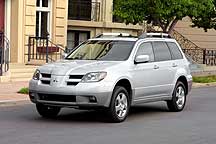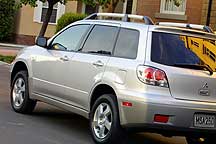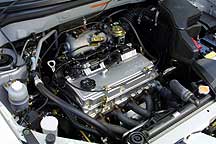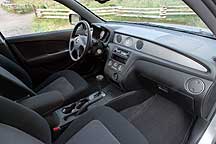
MSRP Range: $18,000 to $24,000
Invoice Range: $16,500 to $22,500
Price Quote
MSRP As Tested: $20,790
Versions: LS, XLS
Vehicle Category: Compact Sport Utility Vehicle
Engine Location: Front Engine
Drive Wheels: Front-Wheel/2-Wheel Drive and All-Wheel Drive
Engine As Tested: 2.4-liter, Single Overhead Cam, Inline 4-cylinder, 140-hp at 5,000 rpm, with 157 lb-ft of torque at 2,500 rpm
Transmission As Tested: 4-Speed Automatic
Fuel Economy (city/hwy): 2-Wheel Drive - 21/26, All-Wheel Drive - 20/25
Standard Safety Features: Driver and Front Passenger, front airbags, front-wheel disc brakes, rear-wheel drum breaks.
Competition: Chevrolet Tracker, Ford Escape, Honda CR-V, Hyundai Santa Fe, Jeep Liberty, Landrover Freelander, Mazda, Tribute, Saturn Vue, Subaru Forester, Suzuki XL7, Toyota RAV4
BEND, Ore. -- Snow, sliced by a plow into a wall three feet high, rims a narrow road wrapping around Mt. Bachelor in the Cascade Range of Oregon, with the three Sisters, white-capped spires thrust into a cobalt sky, filling the three mirrors on a new type of crossover wagon from Mitsubishi as we dash back toward Bend.
No need to sweat slipping and sliding, since the icy stuff remains in banks lining the road and the asphalt seems as dry as the high desert air. Besides, our little wagon totes an all-wheel-drive (AWD) system with viscous coupling differential in the center spot to divide the engine's muscle equally between front and rear wheels.
So all four tires bite the blacktop with steady and predictable traction applied as we take one curve after the next through foothills of the Cascades.
The AWD system is optional on this crossover wagon, which also stocks a feisty four-cylinder engine tied to a four-speed automatic tranny rigged with a clutch-less shift controller that works like a manual stick.
What's a crossover vehicle?
It's one that fits into more than one niche in terms of form, function and style.
In the case of this wagon, the unibody platform comes from a car -- Mitsubishi's compact-class Lancer sedan -- but the format resembles a sport-utility vehicle with a boxy cabin containing room for five riders plus a load of cargo in the rear bay.
The idea of a crossover vehicle combines the easy-to-drive manners of a sedan with the cargo capacity and cabin flexibility inherent in a sport-ute plus the thrifty fuel efficiency of a four-pack engine.
It's part sedan, part SUV and part economy car that's both practical and easy to use.
Mitsubishi tags this one as the Outlander and it comes ashore as the latest model in Mitsubishi's 2003 line.
Outlander divides into the two trim editions of LS and XLS, each stocking the same four-cylinder engine and available with either two-wheel-drive (2WD) or the full-time AWD mode.
The package size -- with 103-inch wheelbase and length stretching to 179 inches -- puts it squarely in the compact class. That makes it small enough to navigate easy through a crowded parking lot yet still large enough in the cabin to provide space for five passengers plus a load of cargo.

At the rear, Outlander has a big hatchback tailgate that swings high for access to the aft compartment, where the floor rises to knee height.
A flexible seat plan with folding seatbacks on the rear bench creates an expandable bay for gear.
It looks sleek but strong in a slick package with aggressive prow and abbreviated hood sloping at a rakish angle into a tipped-back windshield.
A thick pillar at the center of the face has edges that sweep upward into the hood, with flanking two-tier grille ports and bold headlamp clusters on the corners.
Below, a shapely air dam in contrasting color on the top model houses a pair of squared foglamps.
Front fascia wraps around corners to meet wheelwells pinned near front and rear edges, with fender blisters adding shape and dimension to side panels. The line of molding extends low in contrasting color along both sides to stretch lines horizontally, as door pillars go dark so windows seem to run in a continuously line clear back to the forward-canted tail pillar.
The top-hinged hatchback lid wraps the rear as capped by a sporty roof spoiler.
Concealed behind the shapely skin, Outlander's unibody structure in steel carries reinforcements with cross-chassis braces and front sub-frame rail extensions.
The reinforced chassis checks the body's tendency to sway laterally through a curve so Outlander's passenger compartment remains tight and flat.
Aiding this agile attitude, the platform's wide-track stance in conjunction with an independent suspension system contributes predictable stability for Outlander when it's steered through a curvy course.
The suspension puts MacPherson struts up front and a multi-link arrangement at the rear.
It holds the back wheels in line while also damping vertical movement prompted by pavement bumps. The design has a trailing arm and three control arms at each wheel for stability on various surfaces.
Then the big tires (225/60R16) boost the ride height.
The bottom line: Outlander feels substantial in motion, despite its compact size.
It will charge off the line, glide over lumpy pavement, hang hard around corners, and run confidently at speed.

All versions draw power from a familiar Mitsubishi four-cylinder plant -- the same one that drives base issues of Galant sedan, Eclipse coupe and Eclipse Spyder convertible.
The 2.4-liter in-line four, rigged with an overhead cam, four valves per cylinder and sequential multi-point fuel injection, mounts transversely up front and directs all torque to the front wheels. Output reaches to 140-hp at 5,000 rpm, with 157 lb-ft of torque at 2,500 rpm and special tuning to muster more muscle at those lower and mid-range speeds needed for city drivers.
The four-speed automatic contains an adaptive controller linked to a computer that learns a driver's habits and manipulates shift patterns to suit the driving style. Then slide the shift lever laterally into a side gate for the Sportronic manual mode, where fore-aft stick action bumps up or down the gear ladder one notch at a time.
Outlander in LS trim stocks gear like air conditioning, a 140-watt audio system with CD player, power controls for windows and locks and mirrors, cruise control, and reclining rear seatbacks divided 60/40 in sections.
Options extend from alloy wheels to a tubular roof rack, keyless entry system and a cover on the cargo bay.

Outlander XLS adds the roof rack, spoiler and foglamps, plus alloy wheels, white-faced gauges in the instrument cluster and a leather-wrapped steering wheel and shift knob.
Options for the XLS include a premium sound package with 210-watt sound system and power sunroof, a luxury package with heated leather seats, side-impact air bags and heated side mirrors, and stand-alone options for safety with an anti-lock brake system (ABS) keyed to electronic brake force distribution (EBD).
MORE DATA
Where Built: Japan
Seating: 5
Number of Rows: 2
Crash Test Ratings:
- NHTSA Frontal Impact/Driver Crash Test Rating: To Be Determined
- NHTSA Frontal Impact/Passenger Crash Test Rating: To Be Determined
- NHTSA Side Impact/Front Seat Crash Test Rating: To Be Determined
- NHTSA Side Impact/Rear Seat Crash Test Rating: To Be Determined
- NHTSA Rollover Resistance Rating: To Be Determined
- IIHS Frontal Offset Crash Test: Untested
Length in Inches: 179.3
Warranties: 3 years/36,000 miles bumper-to-bumper, 7 years/100,000 miles corrosion, 5 years/60,000 mile powertrain, 3 years/36,000 miles free Roadside Assistance.
Weight in Pounds: 3,461
Towing Capacity in Pounds: 1,500
Maximum Cargo Capacity in Pounds: 905
Gas Tank Capacity in Gallons: 15.7
Destination Charge: $580




